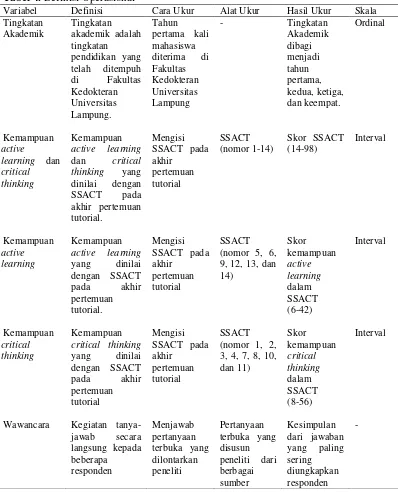Informasi Dokumen
- Penulis:
- Amalia Rasydini Salam
- Pengajar:
- Dr. Diana Mayasari, M.K.K.
- Dr. dr. Muhartono, S.Ked., M.Kes., Sp.PA.
- Dr. Merry Indah Sari, M.Med.Ed.
- Sekolah: Universitas Lampung
- Mata Pelajaran: Pendidikan Dokter
- Topik: Perbedaan Kemampuan Active Learning Dan Critical Thinking Dalam Tutorial Pada Mahasiswa Fakultas Kedokteran Universitas Lampung
- Tipe: Skripsi
- Tahun: 2017
- Kota: Bandar Lampung
Ringkasan Dokumen
I. INTRODUCTION
The introduction outlines the background of the study, emphasizing the importance of active learning and critical thinking skills in tutorials at the Medical Faculty of Lampung University. It highlights the declining quality of tutorials due to students' lack of engagement and ability to brainstorm effectively. The study aims to assess the differences in active learning and critical thinking skills across different academic levels.
1.1 Background
This section discusses the necessity of active learning and critical thinking in medical education. It points out that the current tutorial quality is subpar, with students often disengaged and failing to stay on topic. The aim is to investigate the differences in these skills among students at various academic levels.
1.2 Problem Statement
The problem statement addresses the primary research question regarding the differences in active learning and critical thinking abilities among first, second, third, and fourth-year medical students at Lampung University.
1.3 Research Objectives
This section delineates the general and specific objectives of the study, including assessing the levels of active learning and critical thinking among students and identifying which academic year exhibits the highest and lowest scores.
1.4 Research Benefits
The benefits of the research are outlined for various stakeholders, including the researcher, students, other researchers, and the institution. It emphasizes the importance of understanding these skills for enhancing educational strategies.
II. LITERATURE REVIEW
The literature review provides a comprehensive overview of critical thinking and active learning. It explains definitions, cognitive abilities, and factors influencing these skills. The review also discusses Problem-Based Learning (PBL) and its relevance to fostering these competencies.
2.1 Critical Thinking
This section defines critical thinking and explains its significance in education. It highlights the cognitive abilities involved in critical thinking, such as interpretation, analysis, evaluation, and inference, which are essential for effective learning.
2.2 Active Learning
Active learning is described as an engaging process where students actively participate in their learning. The characteristics and factors that influence active learning, including student involvement and classroom dynamics, are discussed.
2.3 Problem-Based Learning
This subsection explains PBL as a pedagogical approach that emphasizes real-world problems to stimulate learning. It connects PBL with the development of critical thinking and active learning skills, highlighting its effectiveness in medical education.
III. RESEARCH METHODS
This section outlines the methodological framework of the study, including the research design, population, sample selection, and data collection instruments. It emphasizes the quantitative descriptive approach and the use of questionnaires for assessing active learning and critical thinking.
3.1 Research Design
The research employs a cross-sectional descriptive design to evaluate the active learning and critical thinking skills of medical students at different academic levels. This design facilitates a comprehensive analysis of the variables involved.
3.2 Population and Sample
The target population consists of preclinical medical students at Lampung University. The sample size is determined using stratified random sampling to ensure representation across different academic years.
3.3 Data Collection Instruments
The study utilizes the Self Assessment Scale on Active Learning and Critical Thinking (SSACT) as the primary instrument for data collection, ensuring that the assessment of skills is both reliable and valid.
IV. RESULTS AND DISCUSSION
This section presents the findings of the research, including statistical analyses of active learning and critical thinking scores across different academic levels. It discusses the implications of these findings for educational practices.
4.1 Research Findings
The results indicate that second-year students exhibited the highest average scores in both active learning and critical thinking, while third-year students had the lowest. However, statistical analysis revealed no significant differences across academic levels.
4.2 Discussion
The discussion interprets the findings in the context of existing literature, exploring the factors that may influence students' active learning and critical thinking skills, such as motivation and time management.
V. CONCLUSION AND RECOMMENDATIONS
The conclusion summarizes the study's key findings, emphasizing the lack of significant differences in active learning and critical thinking skills among academic levels. Recommendations for enhancing tutorial quality and student engagement are also provided.
5.1 Conclusion
The study concludes that while variations exist in average scores of active learning and critical thinking among different academic years, these differences are not statistically significant, suggesting a need for improved instructional strategies.
5.2 Recommendations
Recommendations include enhancing tutorial engagement through better preparation, fostering a supportive learning environment, and implementing strategies that promote active learning and critical thinking.
Referensi Dokumen
- Promoting learning and achievement through self-assessment ( Andrade H. )
- Navigation problem based learning ( Azer S. )
- Active learning: creating excitement in the classroom ( Bonwell CC, Eison JA. )
- Medical students’ experiences with problem based learning in asia: a literature review ( Caesario M. )
- ABC of learning and teaching in medicine ( Cantillon P, Hutchinson L, Wood D. )






